Funny thing: Have you ever stopped to wonder about whether most people even know what a ruminant is, what it does, or even what it contributes to this planet?
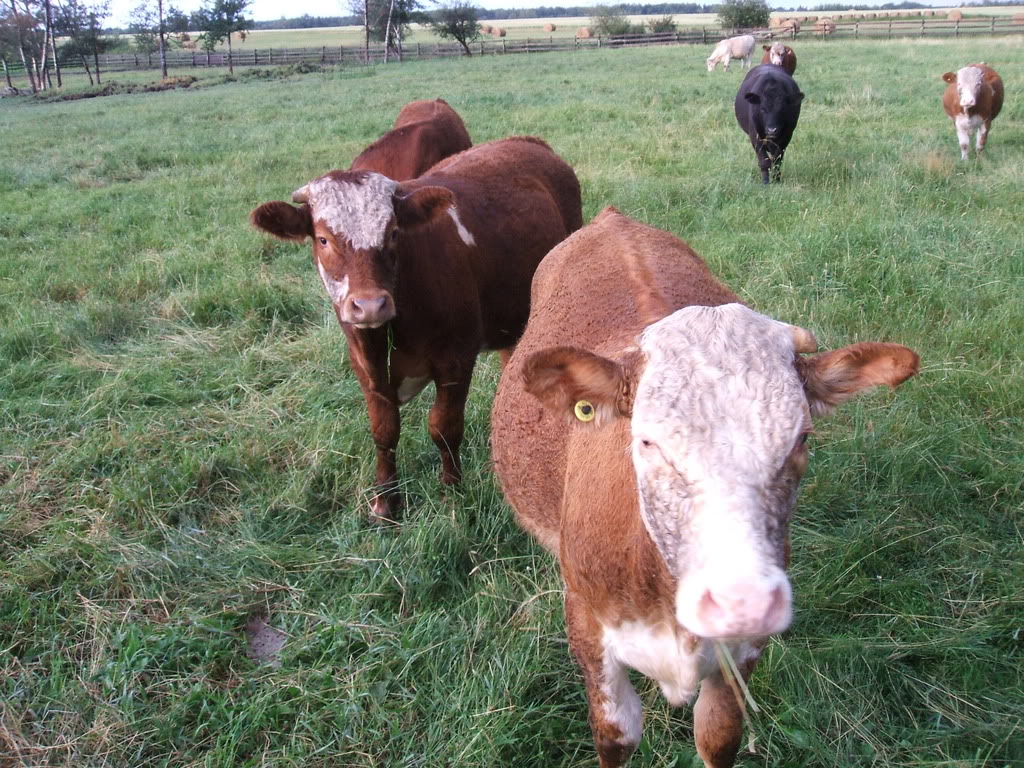
I know, it’s an odd question to even ask—let alone cross a person’s mind—but it bears thinking about when we do get on the topic relating to ruminants, particularly cows. It has been on my mind certainly, especially in light of the negative perception they have been receiving as of late.
While I don’t wish to offend anyone, or even sound cynical, in my experience I’ve found that most people don’t know all that much, if anything, about even the basics of ruminant anatomy and digestive physiology—why cows (plus bison, deer, sheep, goats, etc.) can eat plants. Without an understanding of ruminants eating what they do plus why their digestive system is set up the way it is, it sets the stage for a variety of misinformation encapsulating ruminants—particularly cows. These include bovine methane emissions, feeding of grains (particularly soybeans and corn) to cattle, and the conundrums and debates around grass-fed and grain-fed beef. However, helping you understand more about what makes a ruminant a ruminant sets us all up to better understand how and why these misconceptions that are out there are exactly that.
For this post, I will go over most of the more common questions about ruminants; defining the ruminant, what and how ruminants eat, how the food they eat gets converted to nutrients their body needs, the differences between a ruminant and a monogastric (i.e., a human), and how they can help the environment.
I hope this will be a fun and educational journey for those still interested after the first paragraph. Perhaps you may learn something that you didn’t know before.
Contents
What’s a Ruminant?
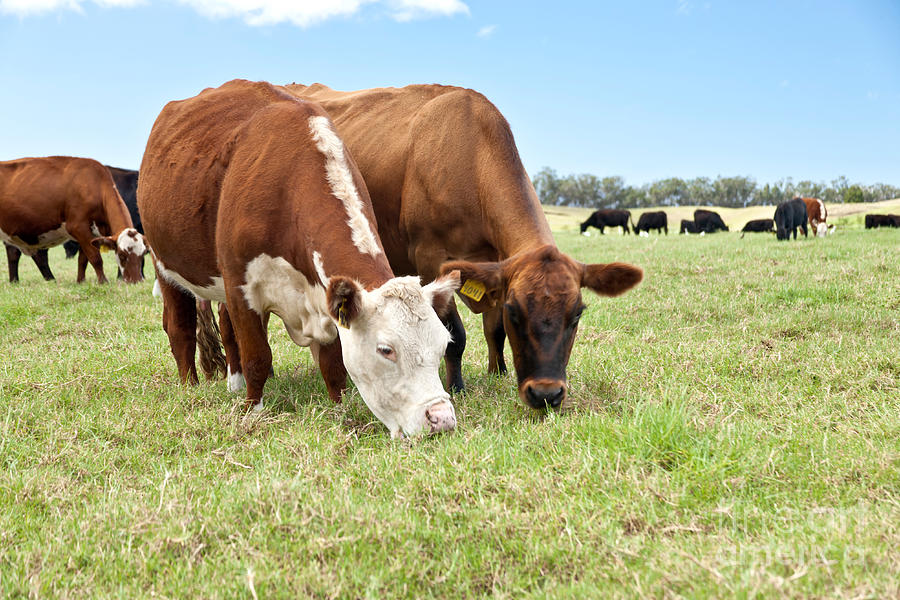
A ruminant, according to the Merriam-Webster Dictionary, is:
“…of or relating to two suborders (Ruminantia and Tylopoda) of herbivorous even-toed hoofed mammals (such as sheep, oxen, deer, and camels) that chew the cud and have a complex 3- or 4-chambered stomach.”
A ruminant has also been known as a ruminant by its habit of chewing cud. Regardless if this is a cow or a deer we’re looking at, most of the time when such an animal is chewing cud, they’re resting. To throw in some anthropomorphism into the mix, one might think that an animal that is resting from eating and chewing their cud is ruminating… via the definition (or one such thing) being, “to think deeply about something.” Whether cows, sheep, deer, moose, goats or other ruminants do ponder deeply about things, like their own existence or why they’re having to chew the cud in the first place, is a philosophical and psychological concept well beyond this very blog.
The only question that remains out of this then, is what makes a ruminant a ruminant? The answer to that question is quite simple: it’s based on what they eat, how they eat, and how that food is digested.
What and How in the World do Ruminants Eat?
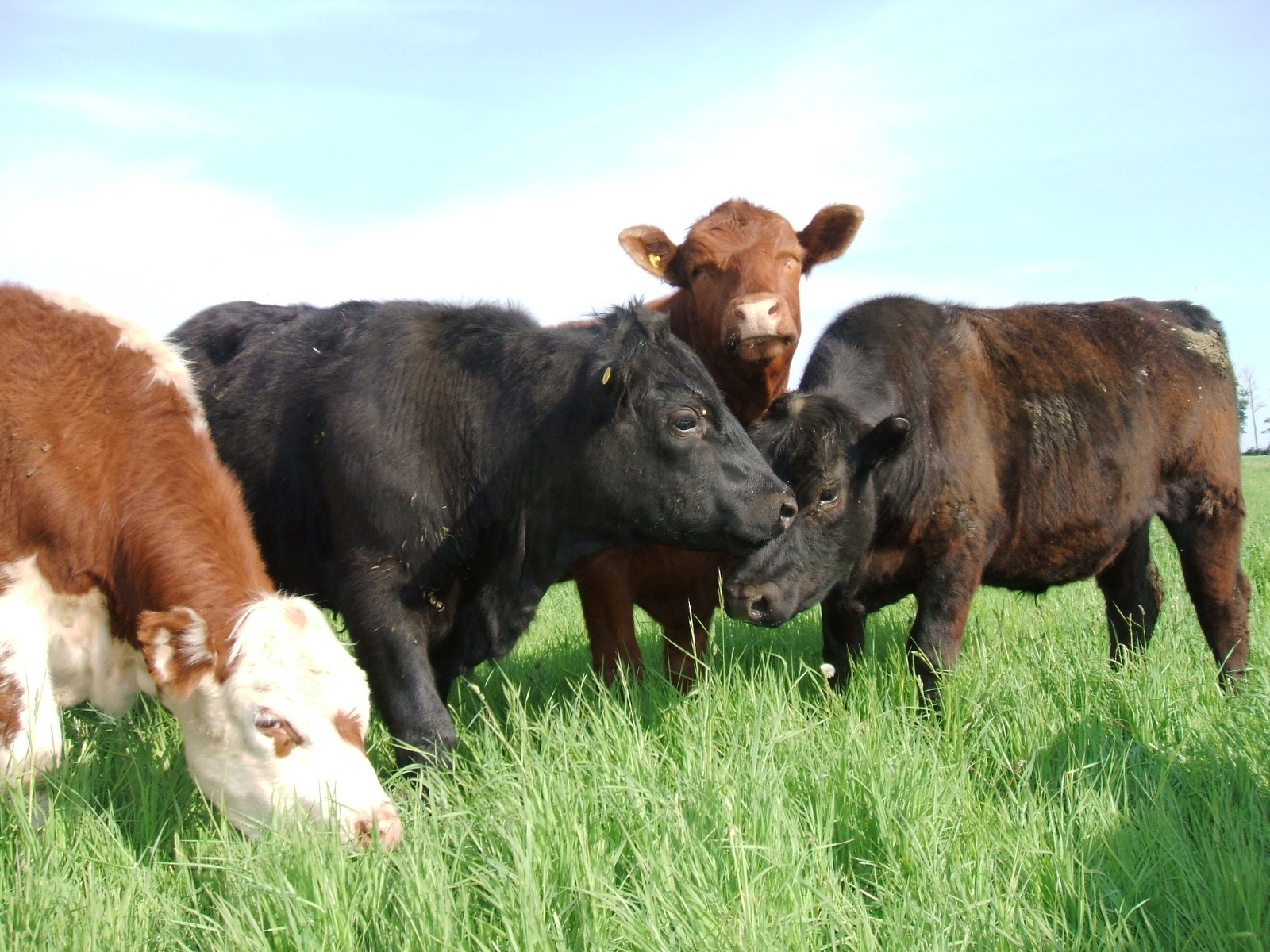
Here’s the super-duper basic answer:
Ruminants are herbivores (plant-eaters). Therefore, ruminants eat plants.
While I’m sure everyone can appreciate such a very simple, to-the-point answer and be happy and move on with their lives with it, not everyone is going to be that happy with such an answer. Not if you’re like me who loves to go down a rabbit hole and a little deeper diggin’.
So, here’s your more scientific and complex answer.
Because the unclassified taxon Ruminantia is comprised of many different species of herbivorous, even-toed ungulates (except members of the porcine family Suidae, such as pigs, warthogs, and peccaries), there is much more variety in what a ruminant eats. Not only that, but there are three different types of ruminants; each type has a certain preference for what can be eaten compared to another type.
Before I get into that, however, there are several things in common among all ruminants, as will be discussed soon: including their four-chambered stomach, all ruminants have no upper incisors, only a hard palate. The only upper teeth they have are flat molars designed for breaking down plant matter into smaller pieces as they chew.
For the most part, chewing for a ruminant is quite brief in the process of actually eating; the main event is when it’s time to chew the cud as it were. While I don’t want to get into the big technicalities behind how long a particular animal spends time chewing before swallowing, I will say this: It depends on the type of ruminant we’re talking about, as well as the dryness and coarseness of the forage that that animal is eating. Basically, the coarser the food source, the more time the animal is going to spend chewing.
For example, a cow grazing on fresh green grass is not going to be spending nearly as much time chewing as she would if she were on dry, albeit coarse hay. A goat is going to spend less time chewing on a succulent stinging nettle plant than he would if he were chewing down some twigs from a dormant sagebrush bush.
Now, for those three types of ruminants. They are:
- Grazer/ roughage/”bulk feeder” ruminants
- Intermediate ruminants
- Browser/”concentrate” ruminants
Grazer or roughage ruminants are the least selective and probably the most versatile of all three types. They may be considered the hardiest of all ruminants, primarily because they are very well adapted to be able to maintain themselves on a diet high in fibre. The most fibrous part of the plant is the components that make up its cell walls, plus the complex carbohydrates; all of which are difficult for most other animals to digest. This particular ruminant group has the largest rumen, for the purpose of slower, more thorough, and complete fermentation and nutrient utilization thanks to a slow rate of passage of food from the rumen to anus. Grasses, sedges, as well as some forbs, shrubs, and the lower leaves of deciduous trees, make up the primary diet of these ruminants. Domestic bovines (cattle), Eurasian and North American bison, Asiatic and African buffalo, domestic sheep, Bighorn and Dall sheep, oryx, guar, wildebeest (gnu), hartebeest, waterbucks, and reedbucks fall into this category.
Intermediate ruminants are the next category of ruminants that are a little more selective in what they eat than your free-for-all roughage-eating grazers. It all depends on the season. They like a little bit of this and a little bit of that, their diet varying widely from grasses and sedges to forbs, shrubs, and tree leaves depending on what opportunistic delectable plant happens across their noses. They’re not as good on higher fibre diets as grazer ruminants are, but they manage. Their rumen is also smaller in size and considered more “moderate” fermentation and metabolic energy rate compared with the aforementioned grazers and the browsers below. Elk (wapiti), domestic goats, mountain goats, pronghorn antelope, muskox, Pere David’s deer, sika deer, Eurasian red deer, fallow deer, ibex, reindeer, and caribou are the main critters that fall into this category. In other parts of the world, such as in Africa, impala, Thompson and Grant gazelles, eland antelope, and steenbok are also intermediate ruminants.
Finally, browser “concentrate” ruminants are the “pickiest eaters” of them all; they can’t efficiently digest the highly cellulosic plant parts like either goats, sheep, or cows do, due in part to their small rumens, high fermentation rates, higher metabolic energy rates, higher feeding frequencies, and their need for high amounts of good quality forage in the diet to meet their body needs. These browsing herbivores deliberately select for plenty of delectable, succulent tree leaves, forbs, and shrubs. This may explain why some of you gardeners have such trouble keeping deer away from your pansies, roses, beet tops, and apple trees! To a browser ruminant like deer (white-tail, mule, black-tail, key) and moose, those are the best parts of the plants to chow down on! Other browsing ruminants include muntjacs, roe deer, gerenuks, mazama, musk deer, giraffes, kudus, bongoes, duikers, pudús, brocket deer, and dik-diks.
If any of you are inquiring about where equines (horses, donkeys, asses, and zebras) and camelids fall into any of this, the simple answer is that they don’t. Camelids–llamas, camels, alpacas, guanacos, and vicuñas–are actually pseudo-ruminants. Unlike true ruminants, they have three stomach chambers, not four. Where ruminants have the rumen, reticulum, omasum, and abomasum, camelids only have a rumen, omasum, and abomasum, but no reticulum. Why? Ask the Man Upstairs; He’ll let you know.
As for members of the Equidae family, these odd/single-toed herbivores are certainly not ruminants; the first half of their digestive system is primarily of a small, simple monogastric-style stomach that flows into the small intestine. No foregut fermentation going on here! Equines are known as hind-gut fermentors, because they have a very large cecum (an organ situated at the beginning of the colon) where much of the food that passed through the small intestine is broken down by anaerobic microbes into volatile fatty acids (VFAs; more on that later) that is used for energy by the animal.
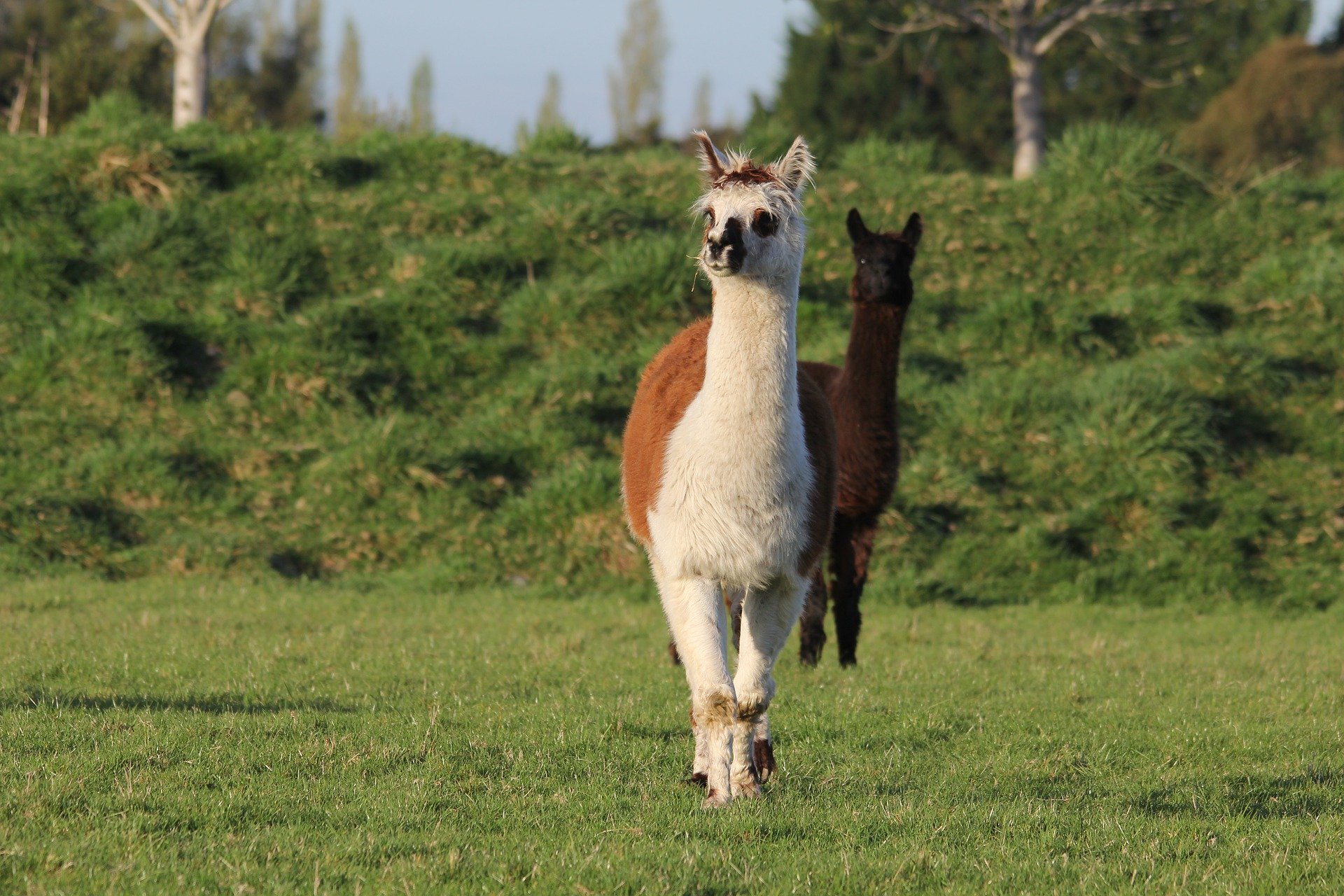
- Camelids like this alpaca are pseudo-ruminants. (Photo from Pixabay.com)
Most of the aforementioned types of ruminants are blessed with the kind of eating habits where they use primarily use their tongues to grasp a plant or feed and pull it into their mouths, and use their bottom teeth to do the shearing or plucking.
What sets the browsers apart from the grazers is the narrower muzzle and often more dextrous lips, making it easier to select for the best, most nutritious parts. They also have longer tongues so they can really reach well for those leaves way up in the tree. Grazers, on the other hand, generally have wider muzzles, shorter tongues, and stiffer lips, making them more adapted to eating grass than delicately selecting particular browse to eat. Intermediate ruminants tend to have a combination of the characteristics from both grazers and browsers in a variety of ways; how they express such characteristics depends on the species.
One thing all ruminants have in common is that famous multi-chambered stomach of theirs.
So, Brown Cow, How Do You Get Your Nutrients?
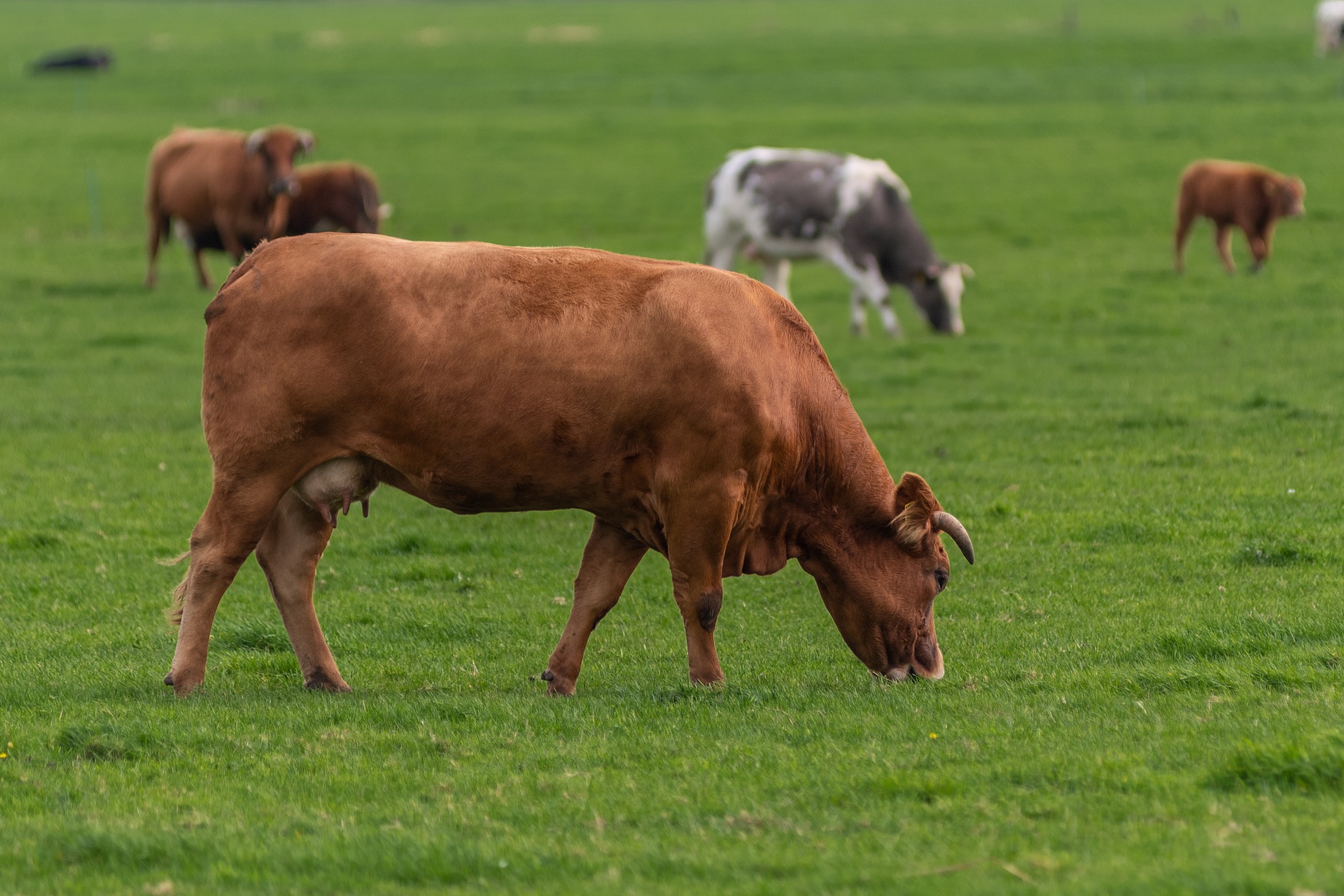
- A brown cow grazing, getting her nutrients for her rumen biota to feed on so they can feed her. Pixabay.com photos.
Forgive me, this is a bovid site where the primary focus is on… you guessed it… bovines. And bison, of course!
The digestive anatomy and physiology characteristics are very similar across all the species mentioned above. However, please don’t set yourself up for disappointment when you find below that I failed to get into the specifics about digestive anatomy with regards to ruminant non-bovids such as deer, goats, and dik-diks. I will most certainly fail to get into those specific details. If I did, this post would be ten times longer than it already is. And I certainly don’t intend to make this very post into a 100-page book! (Even though my blog posts are certainly notoriously long…)
That all said, it’s time I delve right into what makes a ruminant a ruminant: you know, the guts of the situation… pun intended.
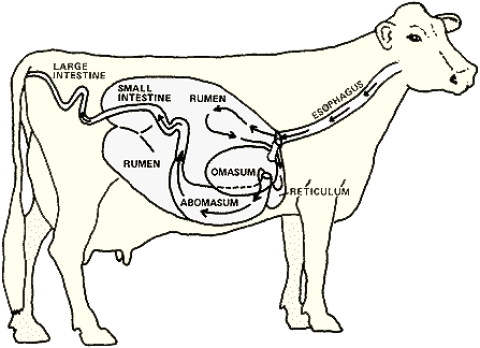
Here’s the thing once again: I could make this the most over-simplified explanation of sorts that tells you, in pretty much one sentence, all that you want to know about ruminant digestive physiology and anatomy. But here’s the problem: I feel that it’s just not enough. I know there’s more than just me who loves to take time out of their day to go down a little rabbit hole and learn so much more than what this sentence (coupled with the Merriam-Webster Dictionary definition above) can tell you:
Ruminants have four multi-chambered stomachs which are the rumen, reticulum, omasum, and abomasum; the rumen is the largest fore-stomach of them all and contains billions of microflora that turn plants into energy and protein for the cow to use for her body.
Yeah, okay, that’s cool, but HOW? And WHY?? What about the real nice juicy science behind all that simplicity?
I know, I know, a number of you reading this will just roll your eyes and wonder why would someone *waste* so much time going into the science when I just gave the answer right there? Well okay, it’s perfectly fine by me if you don’t want to read any further and not wish to go on a little adventure with me from bovine pallet to rectal sphincter. It’s not my job to keep your eyes glued to the screen in reading, with such utter excitement, of how a certain species of bacteria leap onto this fragment of plant cell wall and ooze its cellulose-destroying enzymes to dissolve it, all to suck out (or is it absorb?) the guts of the hapless plant cells… while a hungry protozoan looks on, drooling with anticipation while it stalks its next lunch with ninja-like patience… in the giant, dangerous, wild world that is within the bovine rumen. Nope, my job is just to write and share the information and facts as they stand… and try to make them a bit more enjoyable to read than a scientific journal paper article.
So, for those of you still with me, let’s go on this little adventure, shall we?
From the Bovine’s Mouth
Did you know that a cow produces over a gallon (4 litres) of saliva per day?
What a thing to think about as we get pulled into the cow’s mouth as she wraps her rough and powerful tongue around a sward of grass and pulls it into her mouth, shearing it off the stems with her lower incisors! Dear God, the first thing out of my own mouth is the fact that we get covered in spit; side note, it doesn’t even contain amylase enzymes as our saliva does. Now there’s a D.Y.K.T for you!
That sheer amount of saliva is crucial for a ruminant to eat and digest her food. Without it (or at least very much of it), she’ll choke on that tongue-full of grass that she only chewed on a couple of times before swallowing. When she’s eating hay, she needs to produce more saliva (plus drink more water) to deal with the dryness of that hay, compared with those lush, fresh, green, pasture forages.
She also needs to chew on the dry feed a lot more than with the lush pasture forage; it helps to break down that feed into smaller particles for her not only to be able to swallow but also for her tiny yet enormous rumen microbial army to gain access to. The side-to-side or “lateral” chewing action of her lower jaw shears the plant cell walls apart, allowing rumen microbes access to cell contents further down the line of the digestion process.
Saliva also helps to prevent the rumen contents from getting too acidic (having quite a basic pH of 8.9 thanks to its high concentration of bicarbonates and hydrogen phosphate) which helps in buffering rumen contents and preventing acidosis. Not only that, but it also provides nutrients for rumen microorganisms, adds liquid to the rumen for fermentation (as we’ll see soon), helps digesta to pass through the digestive tract, and can even prevent bloat with its anti-foaming properties. We will revisit the cow’s mouth in a bit to talk about <<spoiler alert>> cud-chewing.
Just like with us, that saliva–not to mention the whole action of chewing–is important to make it easy for the food to travel onwards to the next, and certainly the most important chapter, of our journey.
Into The Reticulorumen We Go
Gulp! Down the esophagus, we go, right down into one of the forestomachs of our bovine “tour guide.” (You think I’m the tour guide? Hehe, I’m just your interpreter!)
Nope folks, we’re not going to the true stomachs of our cow just yet! The next leg of our journey is taking us directly to the three primary forestomachs of the ruminant–the reticulum, the rumen, and the omasum, in that order. After we pay homage to these stomach chambers, only then can we enter the true stomach of the cow, which is called the abomasum.
These three forestomachs are the chambered extensions of the esophagus. Through the process of evolution of over 50 million years ago, these forestomachs have developed the complex capacity of anaerobic (oxygen intolerant) fermentation, as we’ll see very soon, in turning inedible plant matter–inedible to us humans, that is–into nutrients for the benefit of the ruminant itself, and later as food for the predators of such ruminant animals, including us.
Thus our first, albeit brief, stop is in the reticulum. This isn’t the first and last time we visit this first forestomach as we’ll see later. The importance of this particular chamber lays in its ability to catch certain things that ought not to be eaten in the first place, and keep them here. Blame the stiff-lipped, tongue-grabbing ruminant that is the bovine for her ability to put things down here, and her inability to avoid doing so…
Roughage-type ruminant grazing animals like cows (and bison, believe it or not) have the fallibility of not being all that overly picky about what they put in their mouths. While grazing–or even eating a hay bale–they can pick up bits of metal, plastic string, wood pieces, and pretty much anything they can fit in their mouths and then swallow. To us, that sounds rather disgusting and horrid. How could a cow do that to herself? Especially when such foreign objects end up poking a hole in the reticulum and working their way to the animal’s heart, killing it.
And yet, how would a cow know any different? How could she know?? To a cow, eating is the top priority. She may be wondering why she’s chomping down on this really hard thing, or why she’s really having to chew and chew and chew and chew on this very long piece of “hay” or “silage” that is actually plastic baler twine or net wrap… but she doesn’t quite know enough to connect the dots and realize that what she just chomped down on or has to spend so much damn time chewing on isn’t exactly good for her. To unapologetically anthropomorphize said cow, she’ll just shrug off the thought and keep on eating, chewing, and swallowing.
The other thing against her is her inability to spit something out. Again, a cow doesn’t have as dextrous lips as we do to sort out said hard object and send it flying with the help of a bit of tongue and pursed lips coupled with forced air from our lungs. Instead, she’s left with opening her mouth and basically “mouthing” the object out of her mouth, with the action of her head and jaws… plus with some luck. But, really, is a cow actually going to know enough to know if a nail that ends up in the feed or a piece of wire she picked up grazing needs to be spat out? While I don’t speak Bovine and am just the tour guide (*ahem* <<interpreter>> that is) for the Bovine Gastrointestinal Tract Adventure, I think it would be safe to say that she may know; but then again she may not.
If she doesn’t know any better, then those foreign objects wander down the hatch right into the reticulum. And that, folks, is where they remain, getting corroded down over time by the cow’s gastric juices. Because a lot of these foreign objects remain in the reticulum, the other name this first forestomach is known by is the “Hardware Stomach.” Sometimes farmers need to put magnet boluses (which is a very large pill to us, yet small to a cow) down a cow’s throat to be able to catch most of these foreign objects–particularly the more harmful metal ones–and keep them in place. It just helps prevent something like a piece of wire from poking a hole through the cow’s stomach and causing a lot of damage to her, which may lead to her death. These magnets are especially important–and a somewhat less-intrusive solution of sorts compared with a highly invasive measure such as surgery–if the cows are being raised in a location where bits of metal are easy for the animals to pick up, and/or if the farmer has had a past issue with a cow (or bull) contracting what is known as “Hardware Disease.“
Muscle contractions now send us and the partly-eaten forage, minus the foreign objects, up and out of the reticulum into the largest and most famous forestomach chamber of all: the rumen.
The Fermentation Vat
This place is a special kind of place. It’s the organ that defines and what makes a ruminant a ruminant. It’s here where a ruminant proves, beyond a shadow of a doubt, that she is capable of turning grass into organic fertilizer, milk, metabolic power to enable her to live yet another day, and when it’s her time, highly nutritious protein for human consumption.
It’s also here where ruminants have been getting far too much flack for two things which I plan to expand more on in future posts:
- Ruminants, particularly cows, often get blamed for being in “direct competition” for eating plants, “that could otherwise go to other humans,” as critics have often pointed out. Truth is, I’ve never known a vegan for making a meal out of their lawn. Or are ruminant hominids actually real? Hmmm…
- Ruminants, especially cows, also often get blamed for producing methane, a highly potent greenhouse gas, via cow farts–*ahem* oops, I meant belching–that has been reported by special interest anti-cattle environmentalist groups to be burning a hole in Earth’s atmosphere, among other things.
Cheeky facetiousness aside, a ruminant can’t prove that she’s capable of such feats–both the good and the seemingly bad–without this symbiotic, mutually-beneficial relationship she has with billions of microorganisms living in her rumen. These tiny living beings, categorized in a completely different taxonomic kingdom than either her or us, are the ones responsible for feeding her plus themselves. Ain’t that amazing?? Isn’t it also amazing that, without these little “helpers,” if you will, of hers she would slowly starve to death plants, and would have to turn to eat a whole lot more animals to keep her alive to live another day.
See there is, quite honestly, a very good reason why a bovine–or any ruminant animal–is often referred to as a walking anaerobic decomposition vat with a mouth and four legs: that symbiotic, mutually beneficial relationship a ruminant has with their microbial population enables them to utilize the very plants that we humans would never consider eating. Did I not mention that already??
“Wait a minute, Karin, a decomposition vat? I thought ruminants ferment the food they eat!”
Well, both are true, and I’ll get to that in a short minute.
I’ve got another wrench to throw in the gears: Not only would a ruminant perish without the help of that large yet tiny microscopic army in her forestomachs, but she also can die if her little army doesn’t receive enough fibre. (Yet another brain-twister for you: You can also kill a cow with a full stomach of far too much fibre.)
Fibre is basically a type of complex, long-chain plant carbohydrate. It’s not a nutrient and arrives in various forms, most notably cellulose, hemicellulose, and lignin. The microorganisms in a ruminant’s forestomach require cellulose to keep their host healthy and productive; especially for the long haul. This is a far different story than what’s told by most monogastric animals (including us humans), which require virtually little to no fibre or cellulosic material to remain healthy.

- Hay is a good source of fibre for ruminants. Their rumen microbes need it!
So, about that part about fermentation. While there are several types of fermentation that I won’t get into here, the primary type that is most prevalent here is enteric fermentation (you’ve probably heard of the term, commonly connoted with methane emissions from cows). Fermentation is a form of decomposition because it does involve the breakdown of organic matter into much simpler compounds, which is accomplished by microorganisms. However enteric fermentation takes place in an anaerobic (oxygen intolerant) environment, whereas most decomposition and rotting that we’re usually more familiar with takes place in an oxygen-tolerant (aerobic) environment.
And yes, those microorganisms are indeed responsible for feeding the cow. How do they do it? The short answer is that they do it through enteric anaerobic fermentation: the microbes produce end products that the cow can utilize for herself.
Here’s an excerpt that goes into a little bit of detail about ruminal fermentation, taken from the National Academies of Sciences’ book Nutrient Requirements of Beef Cattle, 8th edition, Chapter 2: Anatomy, Digestion, and Nutrient Utilization:
Fermentation… offers unique advantages to the host animal. It provides energy from fibrous materials and supports microbial growth, which in turn provides the animal with amino acids and B-complex vitamins. However, the anaerobic environment… results in the production of end products that are not completely oxidized. Anaerobic microorganisms… produce carbon dioxide (CO2), methane (CH4), volatile fatty acids (VFA), and microbial cells as end products. The VFA are mainly acetate, propionate, and butyrate… […] Fortuitously, ruminants have evolved mechanisms that allow the digestion, absorption, and metabolism of the VFA.
Allow me to talk a little about the microbes themselves first before we go back into the realm of ruminal enteric fermentation.
The rumen itself is a microbial ecosystem of a wide variety of and highly diverse anaerobic microorganisms. These include bacteria, methanogenic archaea, and eukaryotic organisms (such as protists and fungi). Because of such a diversity of microscopic organisms, the ruminant is quite capable of utilizing a variety of different feeds and forages.
Bacteria take up the largest portion of the rumen microbial population, making up almost three-quarters of rumen microbial biomass. There are quite a variety of different types of bacteria, most of which are “cellulolytic” or fiber-loving bacteria, and others which are starch-loving bacteria, and others that perform other functions for our bovine host. The fiber-loving bacteria help the animal break down fibrous plant material by attaching themselves to the feed particles, forming vast colonies, and secreting digestive enzymes to break apart the plant tissues and get the nutrients within plus from the tissues themselves. Starch-loving bacteria break down starch molecules into simpler compounds. Other bacteria that attach themselves to the inside of the ruminal skin layer breaking down urea, scavenging oxygen, and recycling dead skin tissue.
Protists or protozoa are the predators of bacteria. While they account for half of the microbial mass in the rumen and there’s been found to be over 100 different species of protists found in the rumen, by the sheer number they’re a lot fewer because they are much larger than bacteria. They also consume sugars and starch. Protozoa also work in symbiosis with archaea because they generate hydrogen for these methanogens to use.
Anaerobic fungi are very important for fibre degradation in the rumen especially when our cow may get fed a highly fibrous, low-quality diet, and account for almost 1/6th to 1/5th of rumen microbial biomass. Fungi colonize on feed particles similar to bacteria do and germinate to produce hyphae that penetrate and break apart plant tissues. Of course, the bacteria love this, because it gives them greater ability to colonize further within these tissues and facilitate further breakdown.
Then there are the archaea. They only account for a tiny fraction of rumen microbial biomass. Most of these organisms are methanogens or methane-producing organisms. Their primary role is removing hydrogen from the rumen, which is one of the main gaseous byproducts of rumen anaerobic fermentation. They have hydrogenases that split the hydrogen molecule (H2) into hydrogen ions (H+; or represented best as 2H due to electrons being represented as reduced protons) and the additional electrons. They use the electrons from this organic chemical reduction reaction derived from the hydrogen molecule to reduce CO2 to CH4. This chemical reaction helps keep the hydrogen gas levels in the rumen significantly reduced so that it doesn’t result in marked reductions in microbial fermentation.
All of these various organisms have an important role to play in helping our cow break down plant matter in the rumen. Not one type of organism is more important than the other when it comes to digesting the feed that a cow eats. These organisms that run complementary to one another in some way, shape, or form, form a biofilm on the surface of plant tissues; a biofilm that is a complex microbial ecological community that produces a lot of different enzymes that are needed to digest a variety of different feeds and fodder.
These plant tissues are progressively broken down into smaller and smaller molecules that get used by other microbes to produce VFA, vitamins, and cofactors needed by other microorganisms. Such a diverse partnership prevents the accumulation of particular end products of fermentation that could harm the ecology of the rumen as well as the animal herself.
These microorganisms don’t live for very long. The half-life of most of these microbes is only 15 minutes. A large portion of them moves down the bovine digestive tract to be utilized as an amino acid source for the ruminant.
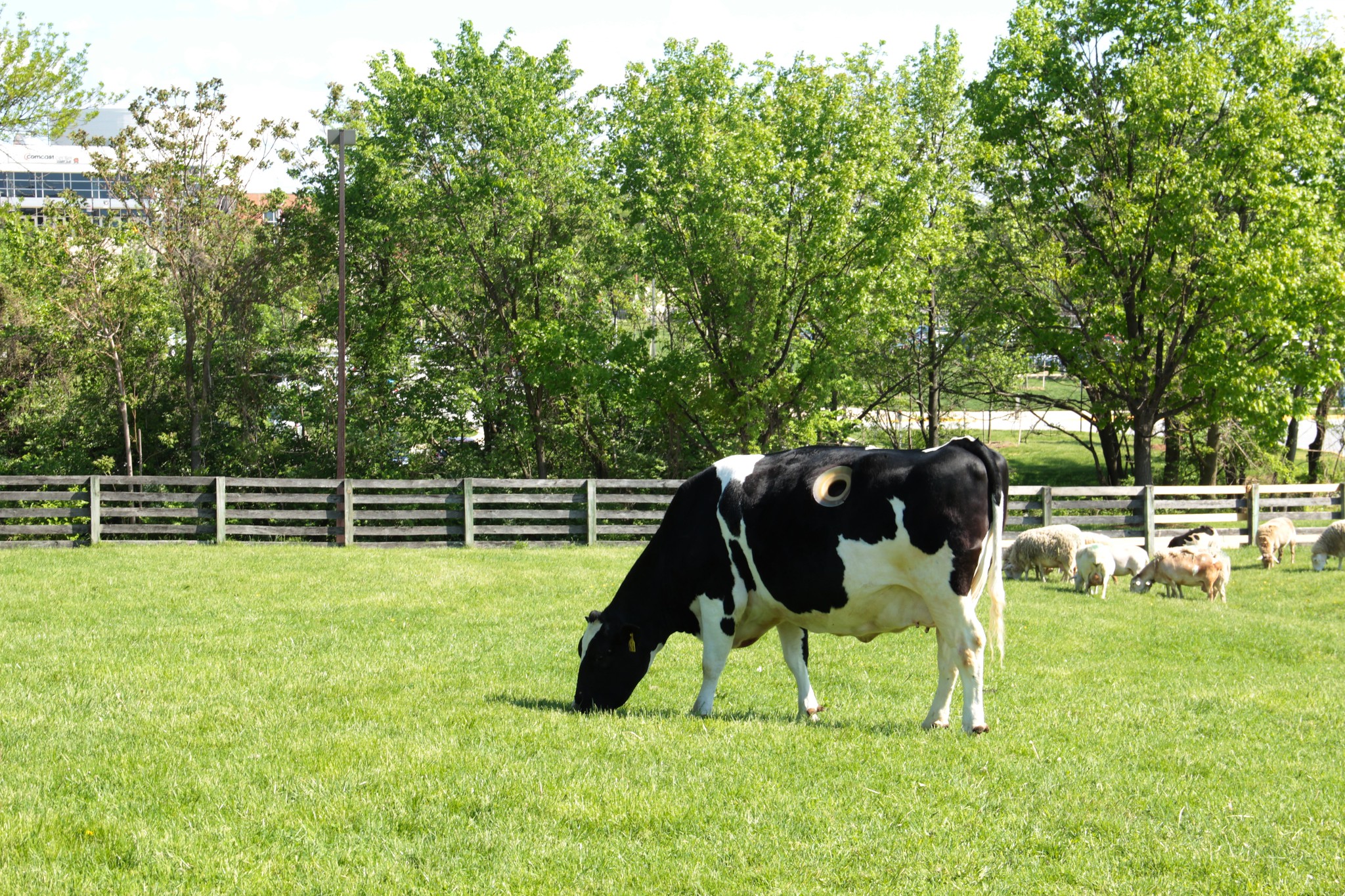
Now, let’s look back again at the process of rumen enteric fermentation because there are two very important nutrients that must be talked about soon: answering the question of just how does our ruminant bovine get the energy and protein she needs from the plants she eats?
The Science Behind Enteric Fermentation
I’ll start us off with another excerpt from Nutrient Requirements for Beef Cattle:
As noted previously, the main products of fermentation are VFA with principal ones being acetic, propionic, and butyric acids. In addition, ammonia (NH3), CO2, CH4, and H2 gas are produced. Long-chain fatty acids are released from lipids [fats], and many other end products result from microbial degradation of minor components of the feed. […] The VFA are largely absorbed across the ruminal wall, thereby supplying an important part of the ruminant’s energy requirements.
In other words, microbes break down carbohydrates into VFA. The VFA is transported across the rumen wall into the bloodstream of the cow, where they are utilized by the cow’s various bodily cells as an energy source. Pretty straightforward.
Byproducts of fermentation are ammonia, carbon dioxide, methane, and hydrogen gas. To reiterate from above, methanogenic archaea take hydrogen gas and convert it into methane, which is released (along with carbon dioxide) through belching.
Cows belch (or rather, more sciencey-speaking, eructate) almost silently, and about once every minute. Cows need to eructate to alleviate pressure on their rumen. If they don’t belch and don’t release those gases, they will bloat. When they bloat up, and if the pressure on the rumen is not released, it puts massive pressure on their lungs to the point where the cow dies from internal asphyxiation. Or to put it more simply, a cow gets suffocated to death from within. Not a great way to go, eh?
There’s just one little snag here. We’ve gone down with some forage that was only partly chewed. There’s another step where this cow of ours is going to be wanting to chew some cud. Not to worry, we’ll return to the rumen again to complete our tour before moving on to the rest of our cow’s digestive tract.
Hear that? More muscle contractions! We’re getting moved back into the reticulum before we… uh oh…
AAaaarrgghh!!!
Mastication and A-Rumination of a Cud-Chewing Cow
Phew!! For a second there I thought I’d become a protist’s next dinner…
What did you say? I’m too big for that? Yeah well, when we’re [imagining] ourselves as being no bigger than the biggest bacteria in the rumen, certain risks are carried with being your Bovine Gastrointestinal Tract Adventure interpreter!
I know, I’m being silly. But, seriously…!
A cow’s rumen and reticulum (hence “reticulorumen”) are always contracting and mixing different sizes of particles and liquid. When it comes time to ruminate, though, a lot of the heavier feed particles in the rumen are moved into the reticulum before they are regurgitated back up into the cow’s mouth to be rechewed.
The whole purpose of rumination via mastication–or rather remastication (mastication is just a fancy scientific word for chewing)–is to break down feed particles into tinier bits that the rumen microbial community can more easily access. That’s it.
A cow will spend anywhere from 30 seconds to over 2 hours per rumination period to chew the cud. One rumination bout lasts from 30 seconds to over a minute, with a new bolus (basically a slimy, salivary/ruminal-fluid-soaked mouthful of feed) being regurgitated, rechewed, then swallowed, and repeated again. Our forage-fed, grazing cow would spend upwards of a total of 8 to 9 hours per day chewing her cud, with a range of 10 to 20 rumination periods to go through every day (or rather, in a 24-hour period). Most rumination occurs during the night, although cows will rest and chew their cud at certain times during the day, usually when they’re feeling the need for a bit of a rest. Still, that’s a lot of regurgitating and chewing.–to us at least; to a cow though, it’s completely normal.
One interesting thing about rumination is that certain feeds can actually inhibit cud-chewing, or rather significantly reduce its daily duration and timeliness. Cattle on a high-concentrate finisher diet only chew cud for around 1 to 3 hours per day; researchers have found that the smaller the feed particles, no matter if it’s silage or grain, the less time cattle spend ruminating, even though the innate desire to do so is still quite strong.
As a matter of fact, scientists have found that highly fermentable feeds (starchy feeds like cracked corn, chopped barley, or rolled oats) can cause the rumen to stop regular contractions; even eating highly-digestible forages that cause the animal to bloat (such as clover and alfalfa) can stop normal reticular-rumen contractions, just as chemical receptors lining the rumen can when they sense that there are much higher concentrations of VFA and urea present and if osmotic pressure is abnormally high. It’s not good for the cow when the rumen stops its contractions. “Ruminoreticular stasis” is not a malady, but rather a symptom of something more serious for a cow, such as acidosis, or bloat; both of which a cow can die from if not treated right away.
This is one of the reasons why feeding cows solely grain without any extra “long-stemmed fibre” or roughage (such as hay, or even straw) is bad for them. Cows–all ruminants–need roughage to stimulate normal rumen motility, stimulate more saliva production, feed their rumen microbial community, and keep rumen pH at a normal range. You literally can kill a cow if you feed her only grain.
While we’re already on our way back to the rumen since our cow has rechewed and swallowed that bolus we got trapped in, let’s continue the discussion about rumen pH and its relation to acidosis.

- These stocker steers sure love their silage… they go nuts over a bit of grain, too.
Acidosis: The Necessary Evil of Grain-Finisher Diets
Boy, that little sub-title might trigger some people…
Acidosis is a digestive disorder that is characterized by an acidic rumen. It’s a common malady for feedlot cattle on finisher diets, though it also raises its ugly head with dairy cows in confinement fed total mixed rations (TMR) containing a higher amount of concentrate feed (such as grain) compared with other long-stemmed feeds like silage and hay.
There are two types of acidosis: subacute or subclinical, and acute (clinical or lactic). The fact whether an animal has subacute or acute acidosis has been determined that it depends on how far down the pH scale the rumen fluid is deemed at. To compare, the normal pH range for rumen contents should be around 5.8 and 6.8, or near-neutral to slightly acidic. For subacute acidosis to occur, rumen pH has to drop below 5.8 down to about 5.5. With acute acidosis, though, pH often drops below 5.2 or 5.0.
Subacute acidosis is usually less of a worry because the rumen “automatically” neutralizes its pH back to normal a few hours after the cow has eaten. With acute acidosis, however, once the pH gets very low, it stays low.
Diets high in concentrates, such as finisher diets where grain makes up at least 90% of the total daily ration, puts animals at great risk of getting acidosis. Cattle who are not gradually transitioned from a forage-based diet to a high-concentrate diet are subjugated to even greater risk of going acidotic. Some very careful feedlot feeding management needs to be done to prevent the risk of cattle going down with acidosis, including (again, from Nutrient Requirements of Beef Cattle, 8th ed.):
…avoiding abrupt changes of diet formulation, maintaining consistent timing of feed delivery, delivering feed at multiple times per day, including ionophore antibiotics in the diet, processing grain consistently and avoiding fine particles, and increasing the dietary proportion of forage help decrease ruminal acidosis in feedlot cattle.
Starch is the biggest culprit for causing acidosis because it’s so easily fermentable. As a result, VFA are much more rapidly produced than with other long-chain carbohydrates like cellulose or hemicellulose, which means that VFA are more quickly dissociated (they release a proton [H+]), causing a decrease in rumen pH.
(Remember from high school science class that a higher concentration of hydrogen ions in a solution makes it more acidic? The more you know…)
Thus, when the dissociation of VFA is greater than the removal of protons (as normally done so through our special archaea friends), ruminal pH decreases.
When the rumen gets so acidic that it can’t go back to normal (without treatment), it wreaks havoc on the rumen microbial community, promoting more acid-loving bacteria than other types (such as lactic-acid producing bacteria). It also damages ruminal epithelial (membranes lining inside of the rumen) which disrupt the barrier that encourages water and nutrient transport and discourages rumen microbes from entering and contaminating intestinal tissue; if the animal doesn’t die from acute acidosis and recovers from immediate treatment but still gets acidosis, it will cause other related health issues including lameness (usually as laminitis), rumenitis (infection in the rumen), and liver abscesses (pustules forming in the liver).
It’s not a very nice way to go, is it?
The only thing that can help reverse acidosis and prevent the animals from really getting it, not to mention continuing to be at risk of getting it, is just by feeding hay or hell, even straw if need be. That long-stemmed fibrous forage gets the animal to salivate more, which helps with buffering pH in the rumen (remember way above when I said that cow’s saliva has a pH of 8.4?), plus it encourages less acid-producing bacteria and more fibre-loving bacteria to take over residence in the rumen.
Forage is very important for the ruminant, well over grain. Grain has its place, no doubt, but it shouldn’t mean expecting a ruminant to perform so well as a monogastric by forcing it to become a monogastric (or, in other words, turning a cow into a pig) by feeding more grain than what’s optimal, let alone necessary!
Yet it’s that conundrum about forage that puzzles most people when it comes to cows: that remaining question of how can get so big and well-muscled on a diet of basically only grass? Why do cows not need extra protein supplements like humans or pigs do to get that muscle mass? I think it’s time to answer that query next.
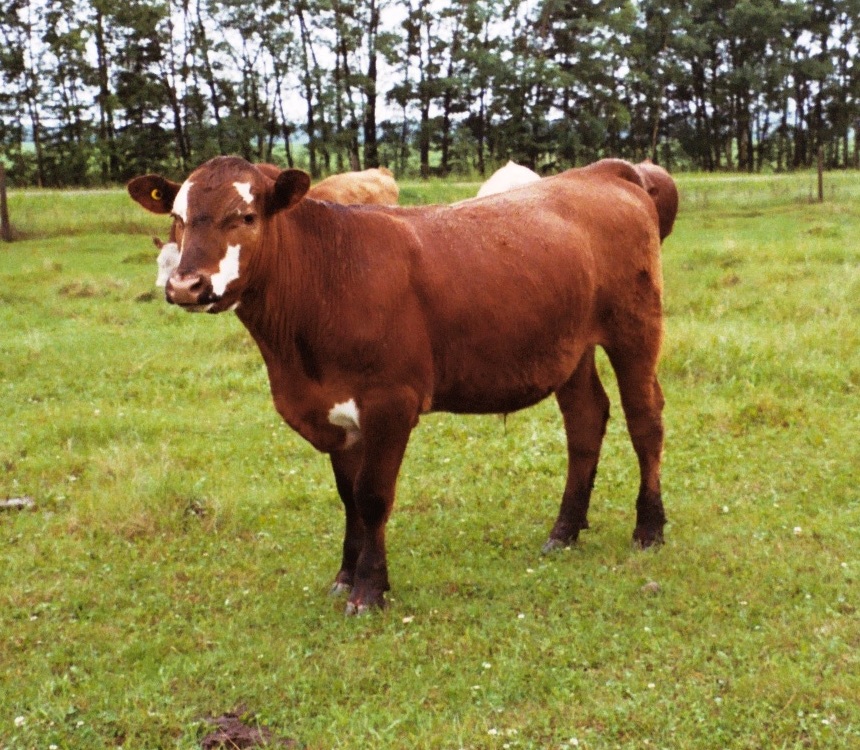
- Whiskeyjack posing for the camera!
How Does a Cow Get Her Protein by Only Eating Grass??
The… fermentation that occurs in the ruminant forestomach transforms dietary protein and NPN [nonprotein nitrogen] into microbial protein and NH3 [ammonia], altering the profile of protein that enters the [small intestine]. Microbial protein is digested [after the rumen], providing the animal with a source of good-quality protein, as all 10 essential AA [amino acids] are synthesized by ruminal microorganisms. Thus the ruminant animal has a unique evolutionary advantage of being able to subsist on diets that contain no true protein.
Our cow, as with all ruminants, has a far more elaborate means of getting her protein than any other non-ruminant on the planet. She has far less of a worry about how and where to get her protein than other animals that don’t have the same wonderfully complex digestive tract as she does, such as us humans. She has her rumen microbial community–coupled with anaerobic fermentation–to thank for that.
Monogastrics–animals with a simple stomach including humans, cats, dogs, and pigs–require their essential amino acids be supplied from outside sources, such as eggs, meat, milk, fish, peas, and canola meal. The proteins are broken down in the stomach and small intestine into peptides, then into amino acids, which are thus absorbed into the bloodstream. For a monogastric animal, the measure of protein that a certain food has is very important (called “protein quality“). This is because it determines how well a certain food can supply 10 essential amino acids to the animal; these are 10 amino acids, out of a total 0f 22 required for making proteins, that must come from the animal’s diet.
For a ruminant, though, such analysis of protein quality is not as important; as a matter of fact, most if it doesn’t even apply! This is because rumen microbes essentially “get in the way” of such simplistic analyses, basically throwing a wrench in the gears–or, should I say, tossing out the window–that which we humans are so used to doing for ourselves when we look at our own dietary needs!
That quote above, which once again I shamelessly pulled from Nutrient Requirements of Beef Cattle (8th edition) gave you a decent summary of how protein is broken down and made available to the ruminant animal. But how about a little more detail?
We’ve already seen what happens to forage when our cow eats it: the chewing action (coupled with rechewing as cud) sheers the plant cells apart making nutrients available to the rumen microbes. The microbes utilize anaerobic fermentation–well, it’s also because the microbes create anaerobic fermentation–to break down these plant tissues into simpler components. Carbohydrates are not the only casualties; proteins also get nailed by microbes and anaerobic fermentation.
Most protein (around 80%) gets degraded down into ammonia (NH3), carbon dioxide, and VFA. We’ve already seen what happens to VFA, so we should be more interested in what happens to NH3 in this particular context.
As such, two things typically happen to NH3: One, microbes use it as a nitrogen source to build protein in their cells for reproduction and growth. Two, NH3 gets absorbed by the animal and converted to urea. The latter I’ll talk about soon.
So it’s no wonder the ruminant can subsist on diets with no true dietary protein! The rumen bacteria and protozoa (the latter to a lesser extent) can grow and reproduce just by using NH3 instead of protein as a suitable nitrogen source.
Microbial cells contain 65% high-quality protein (or rather, protein that is high in essential amino acids). Therefore, when rumen microbes die, they get flushed down the digestive tract into the abomasum and small intestine where they get digested exactly like how monogastrics would digest the protein they’ve consumed. In a lot of cases, this is where most of a cow gets her protein from.
But there’s a glitch in the complexity of protein: not all feed protein is true protein. “True protein” is protein nitrogen or nitrogen that is found in protein. Non-protein nitrogen (NPN), on the other hand, is the nitrogen found in compounds that are not classified as proteins but rather as nitrogenous compounds; these include ammonia, urea, nitrate, nucleic acids, amines, amides, and amino acids.
This comes into importance when measuring crude protein of a feed, versus other different types of proteins that I cannot discuss here as it’s out of context for this post. Such a discussion will be a future installment in the Keeping & Raising Cows Blog.
However, it is indeed true that a lot of protein is degraded by microbes into NPN (which is what ammonia falls into). It’s also true that not all ammonia is used by rumen microbes. The ammonia that isn’t used up by the rumen bacteria is absorbed by our cow and detoxified in the liver, converting it into urea.

- Did you know that you can tell how much protein a cow is getting just by looking at her poop? A “cow pie” like this with good consistency and a dimple in the middle tells a farmer that the cow is getting sufficient protein. Too runny, and the cow is getting too much protein for her and her microbes’ needs. Too piled up and dense, a cow needs more protein in her diet. Source: Wikimedia Commons, Jeff Vanuga, NRCS
That urea can go in two ways: it can be expelled via urine and feces, or it can be recycled back to the rumen. Or both; it largely depends on how much total protein a cow is getting, especially the kind that is readily degraded by rumen microbes (called Rumen Degradable Protein (RDP) or Rumen Degradable Intake Protein (DIP)). Put simply, the greater the amount of protein a cow gets in her diet which the rumen microbes don’t need for themselves, the more of it gets excreted out the back end as urea in urine and feces.
However, the less protein a cow is getting in her diet, especially RDP, the more urea is going to be recycled back into the rumen. The rumen microbes then make use of urea, degrading it down to ammonia (and carbon dioxide), for growth and reproduction. A cow on a low-protein diet will get all urea recycled back to the rumen; a cow on a diet with the right amount of protein will have some of the urea recycled, some (perhaps most) excreted, plus protein that has escaped the rumen. This largely depends on what feed[s] she is eating, because various feeds have different contents of degradable as well as undegradable protein.
Therefore, just to complicate the issue, not all dietary protein is degraded in the rumen; some of it escapes the rumen, only to be broken down in the abomasum and small intestine into amino acids. This is called Rumen Undegradable Protein (RUP) or Rumen Undegradable Intake Protein (UIP).
RDP and RUP are of more importance in the context of feeding cattle for maximum productivity; there’s a theory out there that the more RUP is fed to cattle, the greater their maximum potential for milk production and growth. However, that can be problematic because of a wide variety of factors at play, from just how dietary protein can be degraded in the bovine digestive tract, to the varied RDP and RUP contents in various feeds. There’s a great risk that a lot of potentially valuable RUP ends up being excreted in the feces; this is not much different when an excess of urea produced from diets high in RDP ends up getting expelled via urine. These can also be an environmental concern, especially with cattle raised in confinement operations where manure and urine aren’t going to be readily broken down like what’s expected to occur on pasture, and nitrogen runoff could mean serious consequences for neighbouring waterways.
Are you confused yet? I wouldn’t be surprised if you are: how cows get their protein is a lot more complex and complicated than most people realize!
How ruminants obtain their protein has been an issue that has been studied extensively over the last decade or so; there is a lot of research that has been conducted, and still being conducted to this day. Thus, if you think this little section sounds complicated, I can safely say that I’ve barely scratched the surface: I’ve only given you the very simplified details of how a cow gets her protein. As mentioned above, I may go in a little deeper in some future blog posts…
However, now that we’ve pretty much exhausted the tour of our cow’s rumen, it’s time now to move on to the rest of her digestive tract.
The Final Fore-stomach: The Omasum
I hate to disappoint, but the omasum isn’t nearly as interesting as the rumen from whence we came.
The main purpose the omasum is believed to serve ruminants is to slow down the rush of digesta that is being moved from the rumen into the abomasum. Its other purpose is to act as a massive absorptive “diaper” of sorts, sequestering as much ruminal liquid as possible.
The epithelial tissue of the inside of the omasum is extensively-folded skin, with tiny papillae (small, rounded protuberance on the skin; the inside tissue of the rumen also have a lot of these protrusions) that all help increase the surface area of the omasum to better absorb as much liquid as possible. That means that by the time the rumen contents finally reach the true stomach, we are so densely packed in here that it’s so hard to move around much!
The only other not-so-boring thing I can say about the omasum is that camelids–you know, camels, alpacas, and llamas–lack this particular fore-stomach chamber. They’re actually three-stomach-chambered pseudo-ruminants. Why they lack the omasum, unlike with all other true ruminants, is beyond me, and probably not yet scientifically understood. (I could be wrong, though.)
The Abomasum: A True Stomach of the Ruminant
There’s a very good reason why the abomasum is called the true stomach. It’s the organ of the ruminant that functions in almost the same manner as most non-ruminants (monogastrics) stomachs do.
This particular stomach is the reason why a rumen truly doesn’t have four stomachs, as is commonly communicated to the masses (and which irks me to no end). Instead, a ruminant has three fore-stomachs in addition to their one primary true stomach which has been a part of their existence long before ruminants even evolved to exist!
The abomasum is entirely different from the forestomachs because it has secretory tissue, well over and above absorptive tissue. This tissue secretes hydrochloric acid (HCl), pepsinogen, and mucus.
Pepsinogen in the abomasum is converted to pepsins by hydrochloric acid; pepsins are compounds that get activated by the stomach acid, which then breaks down protein into large polypeptides, plus some amino acids. The large polypeptides meet their fate in the small intestine of the cow, as do other nutrients not quite digested in the abomasum.
Oh, that’s how else our cow can get her protein. Thanks, abomasum!
Into the Intestines
Another digestive organ from which our cow can get her protein (plus starch and some fats) is via the small intestine.
A cow’s small intestine operates much the same way that any monogastric’s small intestine works: it neutralizes the acidic stomach contents that came from the stomach (in this case, the abomasum), and absorbs nutrients into the bloodstream.
Starch digestion is limited in the small intestine, although research is still not clear why. Several types of enzymes, including amylase produced by the pancreas, break down starch into glucose. Glucose is transported out of the small intestine into the bloodstream to be taken up by the cow’s bodily cells as an energy source.
Fats (or lipids) are primarily broken down in the small intestine, as the rumen doesn’t do much justice with that particular job. Bile produced by the liver that is secreted into the small intestine, as well as some pancreatic enzymes, helps break down the lipids present before they cross the intestinal membrane and go primarily into the lymphatic system of the cow.
We’re almost out! Now for the final, final leg of the journey.
Ruminants Have a Cecum Too!
Along with the large intestine, the ruminant cecum helps aid in additional fermentation that may have been missed from what was accomplished in the rumen. More digestion and fermentation in the “hindgut” of the cow helps with further break down of fiber and starch especially. This can be a bit of a plus if a bovine is eating more feed that passes through the reticulo-rumen quickly (like animals on a high-concentrate ration, for instance) because a lot of that missed opportunity gets captured again in the cecum and large intestine.
Like in the rumen, anaerobic fermentation with similar microbial concentrations aids in digestion, producing the same products (VFA, ammonia, methane, carbon dioxide, and microbial cells). Also similar to the rumen, fermentation incorporates nitrogen into the microbial cells, with excess nitrogen getting recycled back into the cow’s digestive tract.
When all is said and done, the rest of the fodder that has been digested as much as possible gets dropped out the anus of the cow into what we would call a “cow pie” (although some refer to it as a “cow pat”; same deal).
And that’s our tour, folks!
Soo… How Can Ruminants Help the Environment? Don’t They Destroy It??
This is a very loaded question that has already been answered in subsequent posts on the Bovine Practicum, so I will try to be brief and succinct here.
Remember when I introduced the rumen of this amazing family of herbivores and mentioned about how the rumen is what makes a ruminant, “a walking anaerobic decomposition vat with a mouth and four legs”?
Well, that’s exactly what makes the ruminant so damn wonderful!
It’s the ability of something like a cow–which has been proselytized by “animal-loving” extremists for being a direct cause of so much environmental destruction and degradation–to be able to literally turn plant matter that we can’t even eat into super healthy, edible, nutritious food for us to eat.
People have been led to believe that cows eat nothing but grain, and therefore are in direct competition with us for land, food and resources.
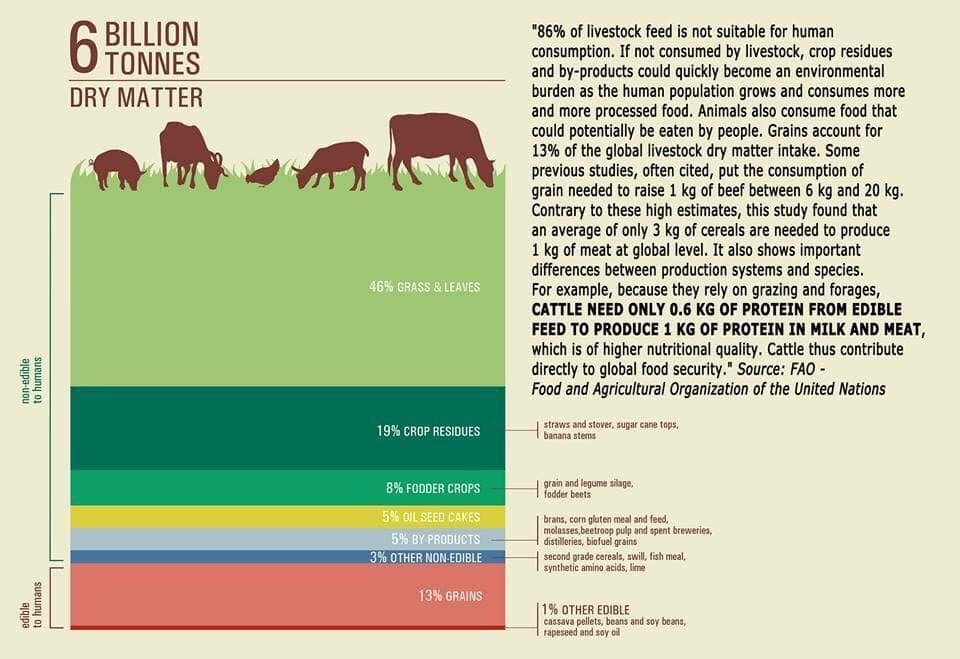
This simply is not true. The graphic above is pulled from the FAO. It is from a study that calculated out just how much do livestock eat versus what the various absurd claims out there on the Internet have said.
Cows, in fact, eat so much plant matter and fodder that they don’t even need to be considered “competition” in terms of human food.
Cattle are grazers; they are raised in areas where it is infeasible and impractical to grow any crops, and their presence in such areas is the reason why wildlife can exist.
Compare those rangelands and pasturelands with croplands which we are usually told by plant-based cultists are “more environmentally friendly,” and ask yourself, where can any wildlife even go? They may pay temporary homage there, but not before they are poisoned by pesticides and they get chased out–if they are lucky–by huge farm machinery that come in to harvest the monoculture.
While it is true that there has been a significant amount of habitat damaged by cattle, it’s actually not by the cattle themselves, but instead by human management.
We have to remember that cows and cattle aren’t wild animals like the bison or the deer are; they are domesticated animals that have evolved and been “naturally” selected over many generations to depend on us for their food, water, health, and shelter. As a result, if a creek is being severely trampled to where the vegetation no longer exists on the banks, or if a pasture looks like it gets overgrazed every summer, that’s because the humans behind the herds don’t know how to better manage those animals so that such environmental degradation doesn’t occur.
What happens when these “invasive” domesticated ruminants are managed properly? The good news is that properly-managed ruminants like cattle, sheep, and goats are found to be highly beneficial to the landscape, with more and more scientific research coming out confirming that “Regeneratively Grazed” livestock increase biodiversity for both plants and animals (thereby creating wildlife habitat for a variety of species), reduce compaction, encourage more soil biological activity, sequester carbon from the atmosphere, increase water holding capacity and water infiltration rates in previously-degraded soils, and contribute to other ecological goods and services.
This is especially true in environments where there is no other man-made tool available to reclaim environments that have been degraded due to human activity, and when “just leave it alone, Nature will take care of it” only exacerbates the damage that is already a big worry. Ruminants will take old, oxidized material and recycle it into fertilizer; fertilizer that contains microscopic life to beget more life, and which can hold a seed or two (more so with roughage eaters like bison and cattle than goats or sheep) to get things going.
To be honest, I have yet to hear of a far superior solution to the wonderful ruminant herbivore than the “let’s just leave it alone and it’ll fix itself” paradigm that is far too prevalent in most environmental “science” (dare I call it pseudoscience?) circles still alive and kicking today.
If you cannot give me the benefit of the doubt, I highly recommend you check out a couple of personal favourite compendiums of evidence from Soil4Climate Inc. and the Ethical Omnivore Movement blog page:
Hope Below Our Feet: Publication Compendium – Soil4Climate
Regenerative Agriculture Works: A Compilation of Evidence – EOM
The ruminant still remains as the most wonderful beast ever “created” or evolved, take your pick on which word to use, to contribute to healthy landscape function and vitality. Very few terrestrial places on Earth can indeed do without the ruminant, but there aren’t very many.
Where To From Here?
My hope with this very lengthy post is that it acts as a precursor of sorts to some future posts I’ve been planning on publishing to this site. These posts include a significant amount of debunking of a lot of all-too-prevalent urban and extremist myths out there pertaining to ruminants, which include the issue around methane emissions, cows being in direct competition for the things that should only go to feed people, and the conundrum–or should I say, accusation–around the “fact” that cows are eating all the soybeans (and canola).
There are more than likely a lot of other topics out there that this post could branch off towards, such as furthering the argument around ruminants getting their protein, and how cows can literally get fat off of eating grass. There’s also a lot of questions that are more around how to raise and manage cattle themselves that I’ve thought of as I spent all the time I did writing this post.
Where to from here, then? There’s a surprising number of paths to take. It’s only a matter of when and how they will be taken.
The main hope, overall though, is that ruminants have a gift that none of us humans have, and it’s that gift–that ruminant digestive tract–that helps them to eat plants that virtually no other types of animals would eat.
Sources:
National Academy of Science. 2016. Nutrient Requirements of Beef Cattle, Eighth revised edition. National Academies Press, Washington D.C. doi: 10.17226/19014
Minson, D.J. 1990. Forage in Ruminant Nutrition. Academic Press, Inc. San Deigo, California. ISBN 0-12-498310-3
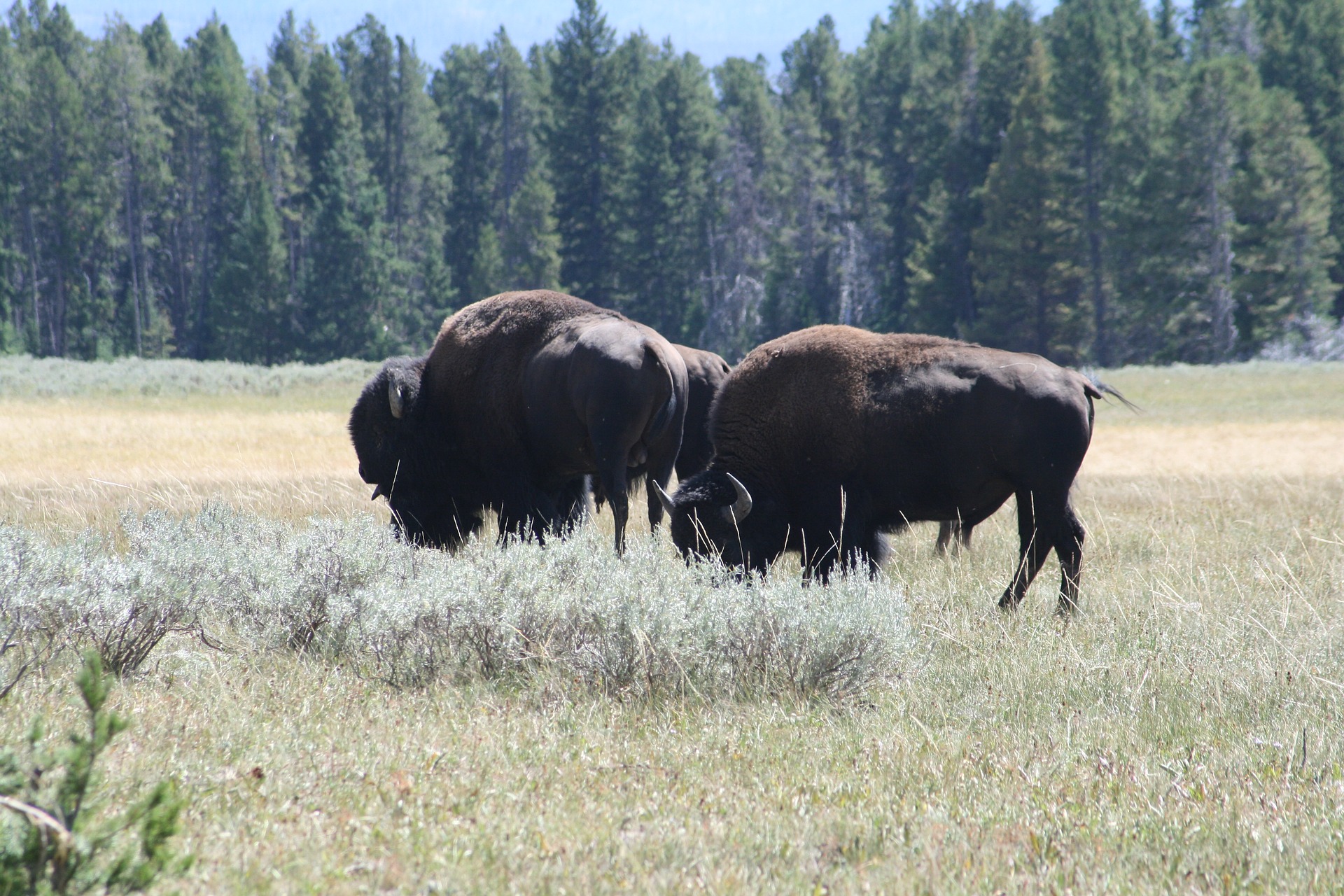
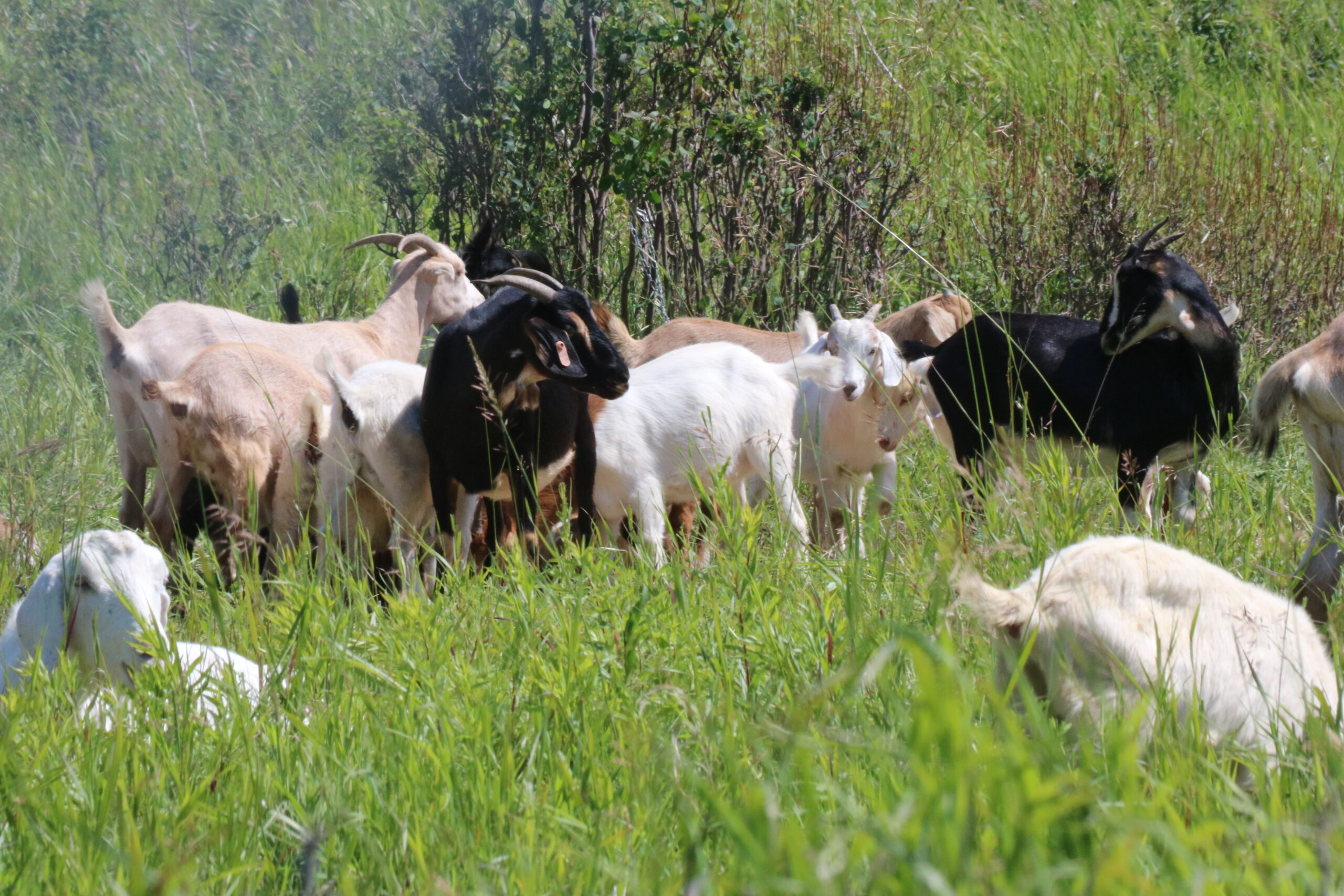
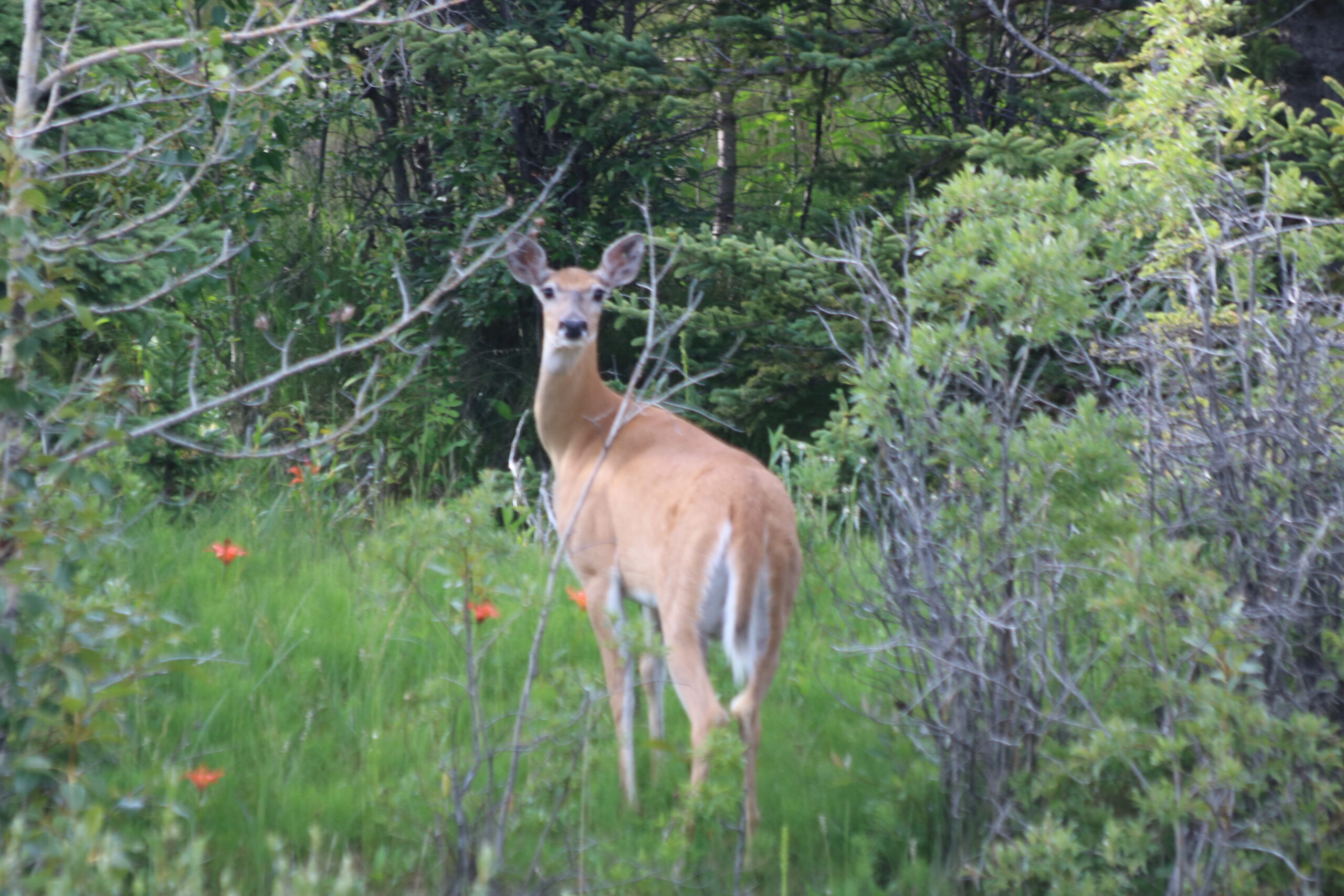
0 Comments
Trackbacks/Pingbacks